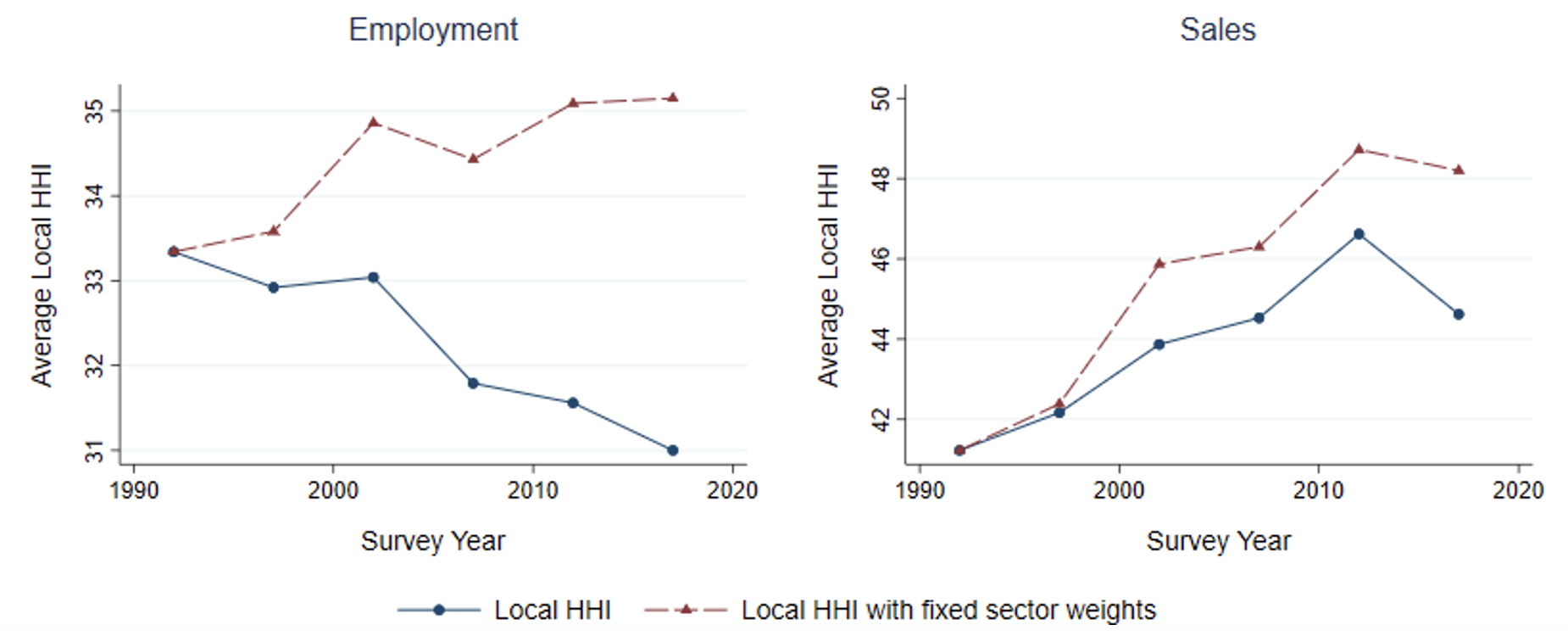The growing heft of large ‘superstar firms’ in the US economy has spurred concerns that rising concentration may harm consumers and workers. New regulations and laws have been proposed and implemented, such as President Biden’s 2021 ‘whole of government’ Executive Order on promoting competition (White House 2021) and the European Union’s Digital Market Act (European Commission 2022). Concentration is not, of course, the same as market power – firms can gobble up market share by offering great products at low prices. Neither, however, can we assume that the rising extent to which a small number of firms account for a large slice of aggregate revenue and jobs is intrinsically benign. Understanding what is happening and why is critical for evaluating any policy responses.
Our earlier research focused on concentration across the whole of the US. In Autor et al. (2020), we used comprehensive US Economic Census data to document that national concentration rates rose across a vast swathe of industries between 1982 and 2012. In many industries, however, product and labour market competition is much more localised. Consumers cannot cross state lines each morning to buy the best cup of coffee, and workers cannot realistically mount nationwide searches for the highest-paying barista job. Indeed, job search is particularly likely to be highly localised for younger and less-educated workers, and for members of dual-earner couples facing the so-called ‘two-body’ problem.’
In new work (Autor et al, 2023), we employ the recently released 2017 Economic Census to investigate concentration over a longer period of time and at both the national and local levels. Consistent with prominent recent studies (e.g. Rinz 2022, Rossi-Hansberg et al. 2021), we find that employment concentration has fallen at the local level, even though it has risen nationally. In contrast, we find that sales concentration has risen at the local level, just as it has at the national level. This latter finding is distinct from some earlier studies (Rossi-Hansberg et al. 2021), likely reflecting the higher precision of the confidential US Census Bureau data used in our analysis.
Our analysis documents that the driving force behind these trends is the reallocation of about one in ten jobs away from manufacturing and towards services since 1982 – a substantial ‘structural transformation’. Because manufacturing is far more locally concentrated than services, this reallocation drives down overall concentration levels. Simultaneously, both sales and employment concentration have risen within local county by industry cells. Rising within concentration overwhelms the de-concentrating force of structural transformation in the case of sales. In the case of employment, however, the opposite occurs.
Summary statistics from our data, which we hope will inform the research and policy debate, are publicly posted here.
Concentrating on the facts
Figure 1 updates Autor et al. (2020) by reporting average national concentration levels through 2017, five years beyond what was available in our 2020 paper. Regardless of how concentration is measured (using the top four firms or top 20 firms; or using sales or employment), national concentration has risen over the last 35 years.
Figure 1 National concentration levels in the US, 1982-2017
Notes: Figure plots the average employment and sales industrial concentration-ratios for the six Census sectors. Sectoral concentration-ratios are averaged across 4-digit SIC industries, respectively weighting all industries by their employment (for employment concentration) and sales share (for sales concentration) each year. The top-4 firm and top-20 firm concentration-ratios, CR4 and CR20, are plotted on left and right axis respectively.
Pooling data across all of the six sectors that are reported in Figure 1 (using consistent NAICS six-digit industry definitions), Figure 2 documents trends in national concentration of employment and sales. Because data on two of these six sectors – Finance and Utilities and Transportation – are not consistently available prior to 1992, we focus here on the 1992 through 2017 period. Using the Herfindahl Index (100 x sum of squared ‘market shares’) as the standard concentration measure (‘HHI’), Figure 2 shows that concentration trends are broadly comparable to those in Figure 1: national concentration has increased in both sales and jobs.
Figure 2 National HHI concentration for employment and sales
Notes: Figure plots the national HHI for employment and sales based on six-digit NAICS industries. In the left panel, industries and sectors are weighted by their employment share each year, and in the right panel, they are weighted by their sales share each year. For ease of reading, we have scaled the HHI such that the theoretical upper bound of ‘complete monopoly’ would be 100 (rather than 10,000 as is often used in anti-trust practice).
We next turn to local rather than national concentration, which we measure using the same Herfindahl index but now calculated at the level of county by six-digit NAICS industry cells. The left-hand panel of Figure 3 shows that employment concentration (blue lines and dots) has fallen at the local level whereas it has risen at the national level, as documented above.
Figure 3 Local HHI concentration for employment and sales
Notes: Figure shows the economy-wide local concentration for employment and sales across six-digit NAICS industries by county cell. In the left panel, local HHIs are weighted by industry-county employment shares each year, and in the right panel, they are weighted by industry-county sales shares each year. In the red lines, each sector's weights are fixed at their 1992 level. These six sectors are the same as in Figure 1: Utilities and Transportation, Manufacturing, Services, Retail Trade, Wholesale Trade, and Finance. For ease of reading, we have scaled the HHI such that the theoretical upper bound of ‘complete monopoly’ would be 100 (rather than 10,000 as is often used in anti-trust practice).
What explains the divergence trends of rising local sales concentration and falling local employment concentration? Figure 1 calculates how concentration would counterfactually have evolved had the employment shares of the six sectors pictured in Figure 1 remained fixed at their 1992 levels. The red dashed line in Figure 3 shows that employment concentration would have risen at the local level, just as it did at the national level. This tells us that the structural transformation of economic activity over this period – with employment share of manufacturing falling by 10 percentage points and employment the share of services rising by the almost the identical amount – can fully account for the fall in employment concentration. Indeed, Figure 3 shows that employment concentration is rising within county-by-industry cells; it is only the countervailing force of sectoral reallocation that prevents it from rising on average.
The right-hand side panel of Figure 3 implements the same exercises for sales concentration. The blue solid line shows that sales concentration has risen at the local level, just as it has at the national level. When we hold constant sector weights at their initial levels (the dashed red line), the implied rise of local sales concentration is even higher. Thus, sectoral transformation has worked against the rise in local concentration in both employment and sales. But structural transformation has had a smaller offsetting effect in sales than employment because the 7 percentage point reallocation of sales from manufacturing to services is smaller than the ten- percentage point reallocation of employment. (This gap reflects the outsized growth of sales-per-worker in manufacturing relative to services.)
Policy implications
The policy implications of these changes are nuanced. For scholars and policymakers worried about the trend of rising national sales concentration, the news that local sales concentration is rising in parallel with national concentration provide further cause for concern. If, on the other hand, one views rising concentration as reflecting the virtuous reallocation of market share from less to more efficient firms, our findings convey further good news.
For those who read employment concentration as an indicator of higher monopsony power (e.g. Azar et al. 2022), the aggregate fall in local employment concentration could be regarded as good news: a young worker placed at random into a job in today’s labour market faces on average a less concentrated set of employers (as defined by a county-industry cell) than three decades ago. But this viewpoint may be too sanguine. Consider a mid-career manufacturing worker possessing extensive industry skills and experience. Because this worker cannot readily switch to a new line of work without taking a large pay cut, the net effect of industrial transformation may be less vigorous competition for their services.
Concentration is not the same as market power. Firms may loom large relative to their sectors precisely because they compete so effectively. Still, the history of antitrust is littered with powerful firms that began life as upstart competitors only to become competition-stifling incumbents. Whether the trends in local sales and employment concentration here bode well or ill for economic dynamism, the powerful undercurrent of structural transformation is a neglected source of the seismic changes we document. Understanding the impact of these structural trends on worker and consumer welfare should be a priority for future research.
References
Autor, D, D Dorn, L F Katz, C Patterson, and J Van Reenen (2020), “The fall of the labor share and the rise of superstar firms”, Quarterly Journal of Economics 135(2): 645–709.
Autor, D, C Patterson and J Van Reenen (2023), “Local and National Concentration Trends in Jobs and Sales: The Role of Structural Transformation”, MIT mimeo
Azar, J, I Marinescu and M Steinbaum (2022), “Labor Market Concentration”, Journal of Human Resources, 57, S167-S199
European Commission (2022), Digital Markets Act.
Hsieh, C-T and E Rossi-Hansberg (2021), “The Industrial Revolution in Services”, Center for Economic Studies, US Census Bureau, forthcoming in Journal of Political Economy: Macro
Rinz, K (2022), “Labor Market Concentration, Earnings, and Inequality”, Journal of Human Resources 57(S): S251–S283
Rossi-Hansberg, E, P-D Satre, and N Trachter (2021), “Diverging Trends in National and Local Concentration”, NBER Macroeconomics Annual 35: 115-150.
White House (2021), Executive Order on Promoting Competition in the American Economy, 9 July.









